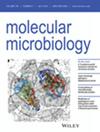大肠杆菌IscR [2Fe‐2S]簇在氧化还原循环剂反应中的作用
IF 2.6
2区 生物学
Q3 BIOCHEMISTRY & MOLECULAR BIOLOGY
引用次数: 0
摘要
细胞对生长抑制氧化还原循环剂的反应机制仅部分被了解。在大肠杆菌K12中,包括ISC和SUF - Fe - S簇生物发生机制在内的IscR调控子在这些药物的作用下表达差异。在这里,我们报道了一种氧化还原循环剂,phenazine methosulfate (PMS)如何通过其[2Fe‐2S]簇辅助因子调节IscR活性。在体外实验中,[2Fe‐2S]‐IscR与isc操纵子1型DNA位点的结合在PMS依赖性减弱中,可以推断出IscR在介导PMS应答中的直接作用。DNA结合的减少归因于其[2Fe‐2S]1+簇的氧化。无氧培养物暴露于PMS中导致isc表达增加,正如预期的那样,IscR簇氧化和isc启动子中1型位点的结合受损。然而,同样的厌氧PMS处理并没有改变2型位点启动子的表达,如suf,这需要缺乏铁- S簇(载子- IscR)的IscR来进行有效的转录调控。相比之下,有氧条件下的PMS暴露显著增加了isc和suf的表达,表明形成了[2Fe‐2S]2+‐IscR和apo‐IscR。这种影响部分归因于PMS在有氧条件下产生的超氧化物,正如一个超氧化物歧化酶缺陷突变体对isc和suf表达的适度影响所证明的那样。总之,这些发现为氧化还原循环依赖的IscR活性调控提供了新的见解,并强调了apo - IscR、[2Fe - 2S]2+ - IscR和[2Fe - 2S]1+ - IscR在控制IscR调控中的不同活性。本文章由计算机程序翻译,如有差异,请以英文原文为准。
The Role of the [2Fe‐2S] Cluster of Escherichia coli IscR in Responding to Redox‐Cycling Agents
The mechanisms by which cells respond to growth inhibitory redox‐cycling agents is only partially understood. In Escherichia coli isc operon type 1 DNA site in vitro. This decrease in DNA binding was attributed to the accompanying oxidation of its [2Fe‐2S]1+ cluster. Exposure of anaerobic cultures to PMS leads to increased isc expression, as expected from IscR cluster oxidation and impaired binding to type 1 sites in the isc promoter. However, this same anaerobic PMS treatment did not change expression of type 2 site promoters, such as suf , which require IscR that lacks an Fe‐S cluster (apo‐IscR) for effective transcriptional regulation. In contrast, PMS exposure under aerobic conditions significantly increased both isc and suf expression, indicating the formation of both [2Fe‐2S]2+ ‐IscR and apo‐IscR. This effect was partially attributed to superoxide generation by PMS under aerobic conditions, as evidenced by a superoxide dismutase‐deficient mutant showing a modest impact on isc and suf expression. Together, these findings provide new insights into redox‐cycling dependent regulation of IscR activity and highlight the distinct activities of apo‐IscR, [2Fe‐2S]2+ ‐IscR and [2Fe‐2S]1+ ‐IscR in controlling the IscR regulon.
求助全文
通过发布文献求助,成功后即可免费获取论文全文。
去求助
来源期刊

Molecular Microbiology
生物-生化与分子生物学
CiteScore
7.20
自引率
5.60%
发文量
132
审稿时长
1.7 months
期刊介绍:
Molecular Microbiology, the leading primary journal in the microbial sciences, publishes molecular studies of Bacteria, Archaea, eukaryotic microorganisms, and their viruses.
Research papers should lead to a deeper understanding of the molecular principles underlying basic physiological processes or mechanisms. Appropriate topics include gene expression and regulation, pathogenicity and virulence, physiology and metabolism, synthesis of macromolecules (proteins, nucleic acids, lipids, polysaccharides, etc), cell biology and subcellular organization, membrane biogenesis and function, traffic and transport, cell-cell communication and signalling pathways, evolution and gene transfer. Articles focused on host responses (cellular or immunological) to pathogens or on microbial ecology should be directed to our sister journals Cellular Microbiology and Environmental Microbiology, respectively.
 求助内容:
求助内容: 应助结果提醒方式:
应助结果提醒方式:


